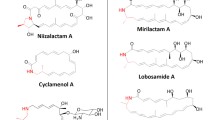Abstract
A novel Streptomyces strain, L10, which is capable of producing natamycin, was isolated from a soil sample collected from Zhejiang province, China. On the basis of phylogenetic analysis of rpoB gene and 16S rDNA sequences, as well as phenotypic comparison, strain L10 (CGMCC 2644) is proposed to be a previously uncharacterized strain of S. chattanoogensis. By screening a cosmid library of strain L10 and primer walking, a partial sequence of scnRI and the entire sequence of scnRII were obtained, which are orthologues to the pathway-specific positive regulator genes of natamycin biosynthesis in S. natalensis. The engineered S. chattanoogensis Dl, generated by inserting an additional copy of scnRII into the chromosome of strain L10, increased its natamycin production by 3.3 fold in YSG medium and 4.6 fold in YEME medium without sucrose.
Similar content being viewed by others
References
Anton, N., M.V. Mendes, J.F. Martin, and J.F. Aparicio. 2004. Identification of PimR as a positive regulator of pimaricin biosynthesis in Streptomyces natalensis. J. Bacteriol. 186, 2567–2575.
Anton, N., J. Santos-Aberturas, M.V. Mendes, S.M. Guerra, J.F. Martin, and J.F. Aparicio. 2007. PimM, a PAS domain positive regulator of pimaricin biosynthesis in Streptomyces natalensis. Microbiology 153, 3174–3183.
Aparicio, J.F., R. Fouces, M.V. Mendes, N. Olivera, and J.F. Martin. 2000. A complex multienzyme system encoded by five polyketide synthase genes is involved in the biosynthesis of the 26-membered polyene macrolide pimaricin in Streptomyces natalensis. Chem. Biol. 7, 895–905.
Bibb, M.J. 2005. Regulation of secondary metabolism in Streptomyces. Curr. Opin. Microl. 8, 208–215.
Chiang, S.J. 2004. Strain improvement for fermentation and biocatalysis processes by genetic engineering technology. J. Ind. Microbiol. Biotechnol. 31, 99–108.
Clayton, R.A., G. Sutton, P.S. Hinkle, Jr., C. Bult, and C. Fields. 1995. Intraspecific variation in small-subunit rRNA sequences in GenBank: why single sequences may not adequately represent prokaryotic taxa. Int. J. Syst. Bacteriol. 45, 595–599.
el-Enshasy, H.A., M.A. Farid, and S.A. El-Sayed. 2000. Influence of inoculum type and cultivation conditions on natamycin production by Streptomyces natalensis. J. Basic Microbiol. 40, 333–342.
Farid, M.A., H.A. El-Enshasy, A.I. El-Diwany, and S.A. El-Sayed. 2000. Optimization of the cultivation medium for natamycin production by Streptomyces natalensis. J. Basic Microbiol. 40, 157–166.
Felsenstein, J. 1981. Evolutionary trees from DNA sequences: a maximum likelihood approach. J. Mol. Evol. 17, 368–376.
Felsenstein, J. 1993. PHYLIP (phylogeny inference package), version 3.5c. Distributed by the author, Department of Genome Sciences, University of Washington, Seattle, USA.
Ficth, W.M. and E. Margoliash. 1967. Construction of phylogenetic trees: a method based on mutation distances as estimated from cytochrome c sequences is of general applicability. Science 155, 279–284.
Flett, F., V. Mersinias, and C.P. Smith. 1997. High efficiency intergeneric conjugal transfer of plasmid DNA from Escherichia coli to methyl DNA-restricting streptomyces. FEMS Microbiol. Lett. 155, 223–229.
Jukes, T.H. and C.R. Cantor. 1969. Evolution of protein molecules, p. 21–132. In H.N. Munro (ed.), Mammalian Protein Metabolism, Academic Press, New York, N.Y., USA.
Karwowski, J.P., M. Jackson, R.J. Theriault, G.J. Barlow, L. Coen, D.M. Hensey, and P.E. Humphrey. 1992. Tirandalydigin, a novel tetramic acid of the tirandamycin-streptolydigin type. J. Antibiot. 45, 1125–1132.
Kieser, T., M.J. Bibb, M.J. Buttner, K.F. Chater, and D.A. Hopwood. 2000. Practical Streptomyces genetics, The John Innes Foundation, Norwich, UK.
Kim, B.J., C.J. Kim, J. Chun, Y.H. Koh, S.H. Lee, J.W. Hyun, C.Y. Cha, and Y.H. Kook. 2004. Phylogenetic analysis of the genera Streptomyces and Kitasatospora based on partial RNA polymerase beta-subunit gene (rpoB) sequences. Int. J. Syst. Bacteriol. 54, 593–598.
Li, H.D., Z.H. Jin, H.G. Zhang, and H. Jin. 2008. Protoplast formation.regeneration and UV mutagenesis of natamycin producing Streptomyces gilvosporeus. Ind. Microbiol. 38, 43–46.
Li, R. and C.A. Townsend. 2006. Rational strain improvement for enhanced clavulanic acid production by genetic engineering of the glycolytic pathway in Streptomyces clavuligerus. Metab. Eng. 8, 240–252.
Lin, H.C., S.C. Chang, N.L. Wang, and L.R Ceng. 1994. FL-120A-D′, new products related to kinamycin from Streptomyces chattanoogensis subsp. taitungensis subsp. nov. J. Antibiot. 47, 675–680.
Locci, R. 1989. Streptomyces and related genera, p. 2451–2508. In S.T. Williams, M.E. Sharpe, and J.G. Holt (eds.), Bergey’s manual of systematic bacteriology. 4th ed. The Williams & Wilkins Co., Baltimore, Maryland, USA.
Saitou, N. and M. Nei. 1987. The neighbor-joining method: a new method for reconstructing phylogenetic trees. Mol. Biol. Evol. 4, 406–425.
Sambrook, J. and W. Russell. 2001. Molecular Cloning: A Laboratory Manual. 3rd. Cold Spring Harbor Laboratory Press Cold Spring Harbor, New York, N.Y., USA.
Shirling, E.B. and D. Gottlieb. 1966. Methods for characterization of Streptomyces species. Int. J. Syst. Bacteriol. 16, 313–340.
Shirling, E.B. and D. Gottlieb. 1972. Cooperative description of type strains of Streptomyces. Int. J. Syst. Bacteriol. 22, 265–394.
Stackebrandt, E., W. Liesack, and D. Witt. 1992. Ribosomal RNA and rDNA sequence analyses. Gene 115, 255–260.
Stratigopoulos, G., N. Bate, and E. Cundliffe. 2004. Positive control of tylosin biosynthesis: pivotal role of TylR. Mol. Microbiol. 54, 1326–1334.
te Welscher, Y.M., H.H. ten Napel, M.M. Balague, C.M. Souza, H. Riezman, B. de Kruijff, and E. Breukink. 2008. Natamycin blocks fungal growth by binding specifically to ergosterol without permeabilizing the membrane. J. Biol. Chem. 283, 6393–6401.
Woese, R.C. 1987. Bacterial evolution. Microbiol. Rev. 51, 221–271.
Zhang, R., A. Zeng, P. Fang, and Z. Qin. 2008. Characterization of replication and conjugation of Streptomyces circular plasmids pFP1 and pFP11 and their ability to propagate in linear mode with artificially attached telomeres. Appl. Environ. Microbiol. 74, 3368–3376.
Author information
Authors and Affiliations
Corresponding author
Additional information
This authors contributed equally to this work.
Rights and permissions
About this article
Cite this article
Du, YL., Chen, SF., Cheng, LY. et al. Identification of a novel Streptomyces chattanoogensis L10 and enhancing its natamycin production by overexpressing positive regulator ScnRII. J Microbiol. 47, 506–513 (2009). https://doi.org/10.1007/s12275-009-0014-0
Received:
Accepted:
Published:
Issue Date:
DOI: https://doi.org/10.1007/s12275-009-0014-0




